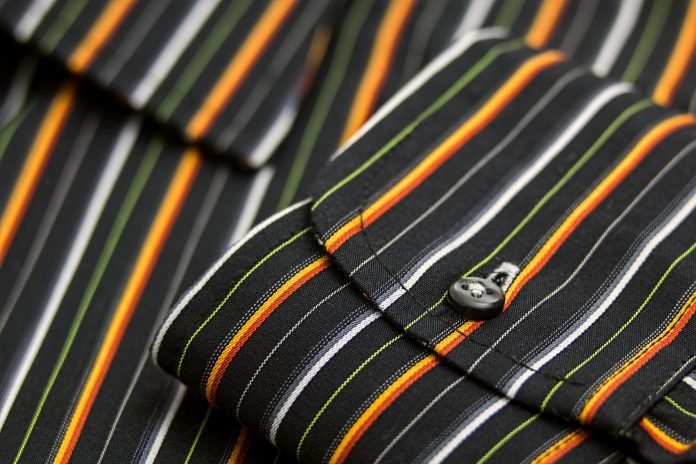Last Updated on July 21, 2024 by Nasir Hanif
The difference between well-tailored or well-picked men’s clothing and those you haphazardly chose can truly make or break first impressions.
This is where the importance of figuring out the basics of men’s apparel measurement comes in. Sure, you might be familiar with the traditional shirt sizing, like small, medium, and large. Or even the numerical sizing.
However, if you’ve gone for a night out and saw a gentleman with what looks like a shirt that’s a perfect fit for his body shape and size, then that’s a person who knows the secrets of men’s clothing measurement and how to use it to his advantage.
Thankfully, we’ve got you covered. Keep reading for our full breakdown of everything you need to know about men’s apparel measurement and how to take your own measurements.
Table of Contents
Men’s Apparel Measurement 101: The Foundational Rules
Let’s start with the overarching rules of measurement. Afterward, we can look at some of the specialized measurements that come with shirt measurements and the like.
The essential dimensions to take when measuring oneself for an item of men’s clothes are:
- Chest
- Neck size
- Waist Hip circumference
- Potential shoulder width
- Arm’s length
You’ll want to grab a soft measuring tape for the majority of the upcoming measurements.
How to Measure Your Chest
Wrap the measuring tape over the broadest portion of your chest and shoulder blades, as well as under your armpits.
If someone is assisting you, relax both arms down. This will help you maintain a natural chest position.
How to Take a Neck Measurement
Place the tape at the base of your neck, where it joins to your shoulders, to measure your neck.
This should be just below your Adam’s apple. Take a comfortable posture and gaze ahead. To ensure the collar isn’t too tight, place one finger between the tape and your body.
How to Take Your Waist Measurement
Bend to one side and look for the crease to determine your natural waistline. After that, wrap the measuring tape around your waist and make sure it’s not too loose or too tight.
Also, make sure it is evenly wrapped around your waist. When measuring for a standard fit, place one finger between the tape and your body.
How to Take Hips and Inseam Measurements
The hip and inseam measurements for men’s trousers or shorts are the same as for women’s.
Wrap the broadest portion of your buttocks for the hip. Then, you can run the tape down, starting from your groin reaching your lower ankle for the inseam.
How to Take the Shoulder Measurements
This is best done with a partner, but you may also measure favorite clothing that fits well.
Not from the front but the rear. Place one end of the tape measure at the point where the horizontal portion of the shoulder and the vertical section of the arm. Then, imitating the natural curvature of your shoulders, you can run the tape over your back.
How to Measure the Length of a Sleeve
Again, you may wish to enlist the assistance of a buddy.
Place one end of the tape at the center of your neck and thread it down your shoulder all the way to the fleshy portion of your palm, i.e., the thenar, to obtain measurements from the back. When you bend your arms, you’ll have more flexibility of movement.
Body Measurements and Size Chart: How Do They Correspond?
Look for a size chart next to each piece of clothing you wish to purchase while shopping online. In most instances, such a chart will contain waist, hip, and bust measurements. It’s simple to figure out what size to buy now that you know your body dimensions.
Keep in mind that various companies have different sizing charts, so double-check them whenever you buy anything online.
Formal Shirts: The Quick Guide on Finding Your Perfect Shirt Measurement
Without a helping hand, obtaining your body measurements may be an uphill struggle, even with the appropriate equipment and techniques.
When you need to find out what size shirt you wear but are on your own, there’s a simpler method to accomplish it: instead of measuring your body, measure your best-fitting shirt from the wardrobe.
Body measurements are not the same as measuring a garment that already exists. Here are a few easy reminders to ensure you get the most out of this shortcut.
Measure your shirt using the following guidelines.
When the collar is stretched flat, the measurement should be measured. Then, take your measurement from the center of the buttonhole to the center of the collar button.
Next, button the shirt and put it flat to measure the chest. Then double the number by measuring from edge to edge slightly below the armpit. Keep in mind that the shirt’s waistband will be the narrowest part.
Along the outer edge, opposite the sleeve seam, measure the sleeve. Begin from the top of the shoulder and work your way down to the cuff’s edge.
For the T-Shirt Lovers: The Fit Profile
At this point, you’re ready for more specialized measurement tips. In this case, we’ll explore the key points of how to pick the perfect T-shirt for your body.
We’ll cover the size, neck, stomach, and sleeve fits.
Overall Size: Shoulders and Chest
Your Size is determined by the breadth of your shoulders and chest.
Most T-shirt companies will provide 11 different sizes, as well as In-Between Sizes for fine tweaking. The sizes are separated by 1/2 inch across the shoulders and 1 inch across the chest.
- Small
- Small/Medium
- Medium
- Medium/Large
- Large
- Large/XL
- XL
- XL/2XL
- 2XL
- 2XL/3XL
- 3XL
Depending on the clothing manufacturer, you might find smaller or bigger sizes available.
How to Measure Shoulders
You may use an existing t-shirt to determine your future t-shirt size.
Start with a t-shirt that fits well through the shoulders. As illustrated below, lay your t-shirt face down on a rigid table (not a bed or other soft surface). Measure from the top of the shoulder to the bottom of the shoulder.
Measure once again to ensure that your dimensions are accurate. Check the list below to see whether your measurement is correct.
Labeled Size = Shoulder Measurement:
- S = 16 3/8
- S/M = 16 7/8
- M = 17 3/8
- M/L = 17 7/8
- L = 18 3/8
- L/XL = 18 7/8
- XL = 19 3/8
- XL/2XL = 19 7/8
- 2XL = 20 3/8
- 2XL/3XL = 20 7/8
- 3XL = 21 3/8
Consider how you would alter the shoulder fit dimensions to improve the fit.
How to Take Chest Measurements
The chest is measured across the t-shirt 1′′ below the armholes.
Measure the chest of your best-fitting t-shirt. This may be the same or a different t-shirt than the one you used for the shoulder measurement. Place your t-shirt face up on a hard surface and take a measurement 1 inch below the armhole and across the t-shirt (like shown below).
Labeled Size = Chest Measurement
- S = 18 3/4
- S/M = 19 3/4
- M = 20 3/4
- M/L = 21 3/4
- L = 22 3/4
- L/XL = 23 3/4
- XL = 24 3/4
- XL/2XL = 25 3/4
- 2XL = 26 3/4
- 2XL/3XL = 27 3/4
- 3XL = 28 3/4
Measure once again to ensure that your dimensions are accurate. Check the list below to see whether your measurement is correct.
When comparing your shoulder and chest dimensions to the charts above, you may see that they correspond to various sizes on our chart. When choosing a size, pay special attention to the shoulder measurement in this instance.
Neck Fit
Some consumers prefer a t-shirt with a more snug fit around the neck. We have a High-Neck option for these clients.
The Neck Fit choices listed below are available.
- Standard: The Most Popular
- High-Neck
The High-Neck is 1/4″ higher around the neck opening compared to Standard Neck. So, High-Neck is considered a bespoke option, which you can find at high-quality men’s clothing companies, like Jasper Holland.
Stomach Fit
In the simplest terms, the region surrounding your navel is known as the stomach fit. You can adjust how much cloth wraps around your stomach with four different stomach fit choices.
The following Stomach Fit choices are separated at the stomach by 1′′ across the t-shirt.
- Stomach Fit: The most popular option
- Extra Slim (2%)
- Slim (36%)
- Standard (48%)
- Classic (3%)
How to Measure Stomach Fit
You may wear an old t-shirt to get an idea of how your stomach fits.
Begin by pulling your best-fitting t-shirt over your stomach. Place your t-shirt on a hard table, facing up, as indicated above. Smooth out any creases and folds, particularly concealed folds on the t-reverse—shirt’s Measure midway between the armhole and the bottom hem of the t-shirt.
Labeled Size = Standard (Not Slim) Stomach Measurement
- S = 18
- S/M = 19
- M = 20
- M/L = 21
- L = 22
- L/XL = 23
- XL = 24
- XL/2XL = 25
- 2XL = 26
- 2XL/3XL = 27
- 3XL = 28
Measure once again to ensure that your dimensions are accurate. Check your stomach measurement against the chart above. Slim is 1 inch shorter than Standard.
Sleeve Fit
Sleeve Fit refers to the amount of space in your sleeve from the bicep to the forearm. All customers should be able to wear both of the Sleeve Fit choices.
- Slim
- Standard
Standard Sleeve Fit will be required if your biceps are bigger than usual. Slim Sleeve Fit is a popular choice if your biceps are average or somewhat smaller than normal.
How to Measure Sleeve Fit
The “short sleeves” sleeve fit is measured across the sleeve opening. The length of a sleeve for “long sleeves” is measured from elbow to elbow.
You may use an existing t-shirt to measure, as illustrated above.
Figuring Out the Men’s Garment Industry Rules
We know that for the majority of men, the idea of figuring out men’s apparel measurement can be overwhelming, especially if you’ve never looked at your sizing details before.
However, we hope that our thorough guide has shed some light on what makes your measurements tick and how to get the right data points.
And, if you enjoyed our article, you’ll definitely like checking out our fashion and lifestyle sections. There we have additional tips and tricks that will make you the best-dressed out of your friend group in no time.
Apart from that, if you are interested to know about Sales on Brands in Pakistan 2021 then visit our Fashion category.






















